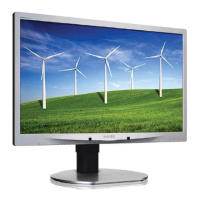
Do you have a question about the Philips 220B4LPCS/00 and is the answer not in the manual?
| Screen Size | 22 inches |
|---|---|
| Resolution | 1920 x 1080 |
| Aspect Ratio | 16:9 |
| Response Time | 5 ms |
| Brightness | 250 cd/m² |
| Contrast Ratio | 1000:1 |
| Pixel Pitch | 0.248 x 0.248 mm |
| Display Colors | 16.7 million |
| VESA Mount | 100 x 100 mm |
| Viewing Angle | 160° (H) / 160° (V) |
| Signal Input | VGA, DVI-D |
| Connectivity | VGA, DVI-D |
| Backlight Type | W-LED system |
| Optimum Resolution | 1920 x 1080 @ 60 Hz |
| Scanning Frequency | 30 - 83 kHz (H) / 56 - 75 Hz (V) |
Highlights potential hazards like shock, electrical, and mechanical dangers during operation.
Guidelines for safe and proper monitor setup, placement, and use.
Instructions for cleaning, handling, and maintaining the monitor to prevent damage.
Specifies conditions for opening the casing and seeking repair assistance.
Details power consumption, heat dissipation, and power supply information.
Illustrates the functional connections between the monitor's main components.
Lists acceptable levels for various pixel and sub-pixel defect types.
Troubleshooting steps for when the monitor does not power on.
Troubleshooting steps for issues with no video display but power LED is on.
Troubleshooting steps for image issues like overlap, focus, or flicker.
Troubleshooting steps for color display problems like miss color or color shift.
Diagram and instructions for connecting hardware for ISP programming.
Steps to install the necessary USB driver for the ISP tool.
Instructions for installing and launching the ISP programming software.
Configuration steps within the ISP tool for setting HDCP key parameters.
Steps to open the configuration window within the ISP tool.
Setting the correct port configuration (FTDI) in the ISP tool.
Instructions for loading the firmware file into the ISP tool for upgrade.
Initiating the firmware programming process using the ISP tool.
Confirmation message indicating successful firmware programming.
Steps to enter the monitor's factory menu using specific button combinations.
Instructions for performing a factory reset through the user menu.
Guidance on resolving checksum comparison failures during ISP.
Alternative methods to try when firmware upgrade fails.
Hardware connection diagram for DDC/EDID programming.
Steps to install the LPT driver required for EDID programming.
Steps to prepare EDID files by renaming and copying them.
Instructions for launching the ISP tool for EDID writing.
Configuring the ISP tool with Analog and Digital settings and loading parameters.
Choosing the appropriate folder containing the EDID files within the ISP tool.
Display of EDID information read by the tool after successful loading.
Entering Serial Number and date, and configuring VGA connection for EDID writing.
Initiating the EDID programming process and confirming successful write.
Procedure to verify the Serial Number via the monitor's user menu.
Troubleshooting steps for common errors during EDID writing.
Lists the required equipment and software for calibration.
Steps for installing hardware drivers and connecting equipment.
Detailed steps for performing the white balance and luminance calibration.
Verifying color temperature settings using a CA-210 analyzer.
Procedure to access the monitor's factory mode for advanced settings.
Details on the Smart Image feature, its OSD outlook, and user operation.
Instructions and requirements for performing PerfectTune II calibration.
Details on factory preset white color temperatures and their CIE coordinates.
Philips' policy on pixel defects for flat panel monitors.
Procedures for performing comprehensive safety checks after service.
Precautions related to fire and electrical shock hazards during service.
Information and precautions regarding X-radiation from the picture tube and HV circuits.
Procedure for checking leakage current with the unit unplugged.
Procedure for checking leakage current with the unit plugged in.
Importance of using correct replacement parts for safety.
